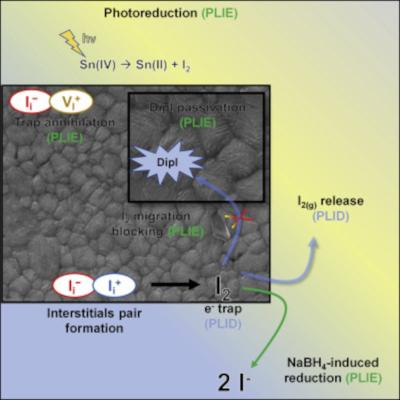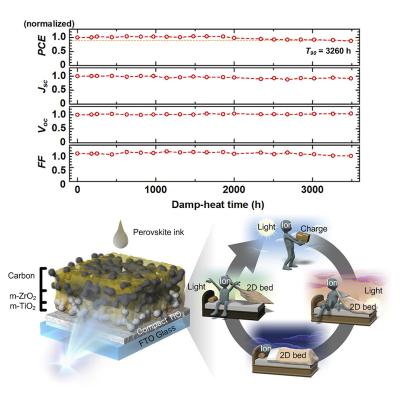 Swiss-based Solaronix was established in 1993 with an aim to supply materials and equipment for the photovoltaics market.
Swiss-based Solaronix was established in 1993 with an aim to supply materials and equipment for the photovoltaics market.
The company provides several materials for perovskite-based solar panel researchers - including titania pastes, perovskite light absorber precursor and hole transport material.
Solaronix is also working on new generation photovoltaic panels. Their ability to work in diffuse light conditions, coupled with new possibilities of design, make these solar modules applicable to a variety of novel situations. Also, Solaronix has solar simulation equipment that delivers continuous artificial sunlight 24/7, allowing for accurate stability and performance assessments of solar cells at laboratory and industrial scales.
Rue de l'Ouriette 129
1170 Aubonne
Switzerland
Researchers show that strong-bonding hole-transport layers reduce ultraviolet degradation of perovskite solar cells
Researchers from the University of North Carolina at Chapel Hill, Colorado School of Mines, National Renewable Energy Laboratory (NREL), University of Toledo and University of California San Diego have pointed out that the light-emitting diodes (LEDs) used in indoor testing of perovskite solar cells do not expose them to the levels of ultraviolet (UV) radiation that they would encounter in actual outdoor use.
The scientists reported degradation mechanisms of p-i-n–structured perovskite solar cells under unfiltered sunlight and with LEDs. Weak chemical bonding between perovskites and polymer hole-transporting materials (HTMs) and transparent conducting oxides (TCOs) reportedly dominate the accelerated A-site cation migration, rather than direct degradation of HTMs.
Tin perovskite solar cells achieve improved stability thanks to additives
A research team, led by Professor Ivan Mora Ser from the Institute of Advanced Materials (INAM) of the Universitat Jaume I of Castell, has improved the efficiency and durability of tin perovskite solar cells. The cells presented in the recent study exceeded 1,300 hours of operational stability, thanks to the incorporation of additives in the preparation of the devices.

Tin-based halide perovskites are being studied as potential candidates for lead-free perovskite solar cells. In the case of tin, an efficiency of more than 14% has been achieved so far, but it has major stability problems. This new work has introduced a combination of dipropylammonium iodide and sodium borohydride, two additives that have made it possible to prepare devices with PCEs of more than 10%, which boast greater stability and have maintained 96% of the initial PCE after 1,300 hours under solar illumination in a nitrogen atmosphere.
Researchers examine light-induced performance increase of carbon-based perovskite solar module
Scientists from Japan's Kishu Giken Kogyo and University of Hyogo, Switzerland's Solaronix and Germany's Fraunhofer ISE have examined the long-term stability of perovskite solar cells using layers of mesoporous carbon, building on previous work that showed the strong potential of this approach.
Schematics of reversible light-induced performance increase for m-CPSM. Image from study
This recent work demonstrated a light-soaking effect, which allowed them to fabricate cells that retained 92% of their initial performance after 3,000 hours in damp heat conditions – which the researchers say is equivalent to 20 years in the field.
Researchers improve perovskite-based solar-cells' performance
Researchers at Aalto University have developed a method for improving perovskite-based solar cells, that builds on previous breakthroughs improving the efficiency and longevity of such cells using printing methods (carbon back contact based perovskite solar cells or CPSCs). These findings make it possible to further enhance the efficiency of these types of solar cells.
In the new method, the perovskite solar cells were exposed to 40-degrees in a chamber where humidity was kept in the level of 70% (±5%). This kind of environment normally degrades the properties of perovskite solar cells. In this case, the treatment led to surprising growth of the perovskite crystals, which naturally absorb sunlight and generate electricity. 'The photovoltaic performance was significantly enhanced, and the overall efficiency increased almost 45%,' say the researchers.
Warwick U team designs tin-based perovskite solar cells
Researchers at the University of Warwick in the UK designed an environmentally friendly perovskite solar cell in which lead is substituted for tin with reportedly undiminished rates of performance but at cheaper cost and with lower toxicity.
The team stated that tin-based perovskites are much more stable than previously thought, and also render solar power cheaper, safer and possibly even more commercially attractive. "The device structure can be greatly simplified without compromising performance, which leads to the important advantage of reduced fabrication cost" the scientists say.




